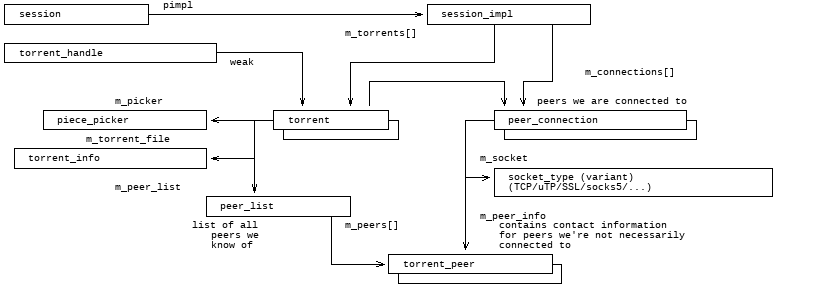libtorrent hacking
| Version: | 2.0.11 |
|---|
Table of contents
This describe some of the internals of libtorrent. If you're looking for something to contribute, please take a look at the todo list.
terminology
This section describes some of the terminology used throughout the libtorrent source. Having a good understanding of some of these keywords helps understanding what's going on.
A piece is a part of the data of a torrent that has a SHA-1 hash in the .torrent file. Pieces are almost always a power of two in size, but not necessarily. Each piece is split up in blocks, which is a 16 kiB. A block never spans two pieces. If a piece is smaller than 16 kiB or not divisible by 16 kiB, there are blocks smaller than that.
16 kiB is a de-facto standard of the largest transfer unit in the bittorrent protocol. Clients typically reject any request for larger pieces than this.
The piece picker is the part of a bittorrent client that is responsible for the logic to determine which requests to send to peers. It doesn't actually pick full pieces, but blocks (from pieces).
The file layout of a torrent is represented by file storage objects. This class contains a list of all files in the torrent (in a well defined order), the size of the pieces and implicitly the total size of the whole torrent and number of pieces. The file storage determines the mapping from pieces to files. This representation may be quite complex in order to keep it extremely compact. This is useful to load very large torrents without exploding in memory usage.
A torrent object represents all the state of swarm download. This includes a piece picker, a list of peer connections, file storage (torrent file). One important distinction is between a connected peer (peer_connection) and a peer we just know about, and may have been connected to, and may connect to in the future (torrent_peer). The list of (not connected) peers may grow very large if not limited (through tracker responses, DHT and peer exchange). This list is typically limited to a few thousand peers.
The peer_list maintains a potentially large list of known peers for a swarm (not necessarily connected).
structure
This is the high level structure of libtorrent. Bold types are part of the public interface:

session_impl
This is the session state object, containing all session global information, such as:
- the list of all torrents m_torrent.
- the list of all peer connections m_connections.
- the global rate limits m_settings.
- the DHT state m_dht.
- the port mapping state, m_upnp and m_natpmp.
session
This is the public interface to the session. It implements pimpl (pointer to implementation) in order to hide the internal representation of the session_impl object from the user and make binary compatibility simpler to maintain.
torrent_handle
This is the public interface to a torrent. It holds a weak reference to the internal torrent object and manipulates it by sending messages to the network thread.
torrent
peer_connection
peer_list
piece_picker
torrent_info
threads
libtorrent starts at least 3 threads, but likely more, depending on the settings_pack::aio_threads setting. The kinds of threads are:
- The main network thread that manages all sockets; sending and receiving messages and maintaining all session, torrent and peer state. In an idle session, this thread will mostly be blocked in a system call, waiting for socket activity, such as epoll().
- A disk I/O thread. There may be multiple disk threads. All disk read and write operations are passed to this thread and messages are passed back to the main thread when the operation completes. This kind of thread also performs the SHA-1/SHA-256 calculations to verify pieces. Some disk threads may have an affinity for those jobs, to avoid starvation of the disk.
- At least one thread is spawned by boost.asio on systems that don't support asynchronous host name resolution, in order to simulate non-blocking getaddrinfo().

